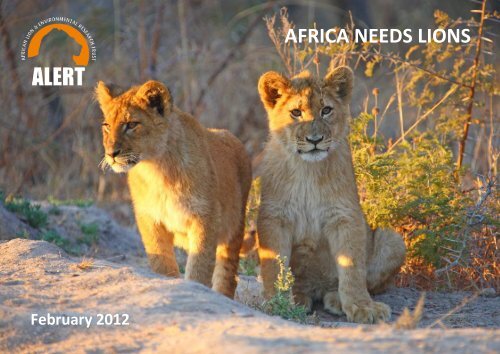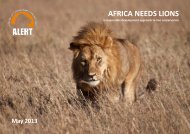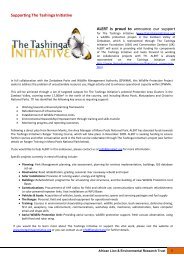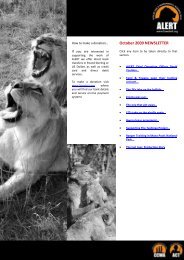AFRICA NEEDS LIONS - African Lion & Environmental Research Trust
AFRICA NEEDS LIONS - African Lion & Environmental Research Trust
AFRICA NEEDS LIONS - African Lion & Environmental Research Trust
You also want an ePaper? Increase the reach of your titles
YUMPU automatically turns print PDFs into web optimized ePapers that Google loves.
February 2012<br />
<strong>AFRICA</strong> <strong>NEEDS</strong> <strong>LIONS</strong>
As the Ngamo pride’s<br />
eldest cub reached her first<br />
birthday this month it is with no small<br />
amount of satisfaction we are able to report<br />
she has been witnessed initiating her very<br />
own first hunts. All that hanging out<br />
with aunts Nala and Narnia appears to be<br />
paying off.<br />
While she’s shown interest in prey prior to<br />
this, and attempted to get involved in the<br />
elder lionesses’ hunts, the 8 th of January<br />
saw her actually leading the hunt on a herd<br />
of zebra. With a 60 metre gap to close down<br />
she rose to her feet and began to stalk<br />
towards them – her shoulders hunched high<br />
as Ashanti and Phyre monitored her<br />
progress. For one of her first efforts she<br />
didn’t do badly at all, getting to within 20<br />
metres of the herd before not being able to<br />
contain her excitement any longer and<br />
bursting into a chase, getting as close as five<br />
metres. A very promising start, but perhaps<br />
one or two more lessons with the Ns<br />
wouldn’t hurt.<br />
When not showing what a big grown-up she<br />
is now, AT1 and the rest of the pride have<br />
been getting to know their youngest<br />
recruits; Ashanti and Kenge’s cubs. Early in<br />
the month it was still only Kenge’s cubs that<br />
were making regular trips out of the den<br />
with mum, and it was on one such occasion<br />
that KE3 & KE4 (now both believed to be<br />
females) got a thorough going over from<br />
AT1. As the young lioness arrived at<br />
waterhole 3 on the 6 th January her attention<br />
was riveted on Kenge and her cubs as she<br />
suckled them.
As AT1 approached Kenge, a similarly curious<br />
KE4 moved towards AT1 and greeted her elder<br />
half-sibling. Unfazed, KE4 seemed to want to<br />
play, but AT1 was a little more cautious – still<br />
making her mind up about this small stranger<br />
and watched from a safe distance.<br />
With Kenge’s cubs now fully integrated into the<br />
pride, concern was starting to grow by mid-<br />
January that Ashanti too seemed to have rejoined<br />
the pride – permanently, without her<br />
cubs. But of course, she actually had the<br />
situation perfectly under control. On the 11 th<br />
January all other pride members except Ashanti<br />
were in Etosha, but it wasn’t long before she<br />
pitched up too and this time she had her two fit<br />
and healthy young cubs in tow.<br />
Immediately the important business of play<br />
started between the four young cubs, with<br />
Ashanti’s younger two managing to hold their<br />
own very well against the KE pair.<br />
With four new mouths to feed the Ngamo pride<br />
is going to need all the help that AT1 can give<br />
them with her new-found hunting talents. The<br />
dinner table is getting awfully full! And, of<br />
course, there’s the exciting possibility that<br />
Phyre may also be due with her own litter in<br />
February. The Ngamo release site – soon to be<br />
the Ngamo crèche!
On the 22 nd of January staff of<br />
Mukuni Big Five (MB5) alerted <strong>Lion</strong> Encounter<br />
Zambia that a lion may be present in the<br />
Songwe area of Livingstone. All <strong>Lion</strong> Encounter<br />
and ALERT lions were accounted for – as were<br />
those belonging to MB5. It was clear this was a<br />
wild lion.<br />
The following day a team of Zambia Wildlife<br />
Authority (ZAWA) scouts and MB5 staff found<br />
spoor and a dead cow in the area, indicating<br />
that he had not moved away from the area<br />
overnight.<br />
<strong>Lion</strong> Encounter in conjunction with ALERT<br />
sought permission from ZAWA to capture and<br />
relocate this lion. We believe had we not taken<br />
this step he would have likely been<br />
destroyed. Dr Ian Parsons, wildlife vet and an<br />
expert in game capture, headed urgently to<br />
Livingstone arriving on Tuesday the 24 th .<br />
Whilst waiting for his arrival <strong>Lion</strong> Encounter<br />
provided bait in an effort to keep the lion in<br />
the same area to facilitate capture and to stop<br />
it venturing into villages looking for livestock.<br />
<strong>Lion</strong> Encounter General Manager, Richard<br />
Leach, headed the operation with Dr Ian<br />
Parsons, and over the next few days the rescue<br />
team attempted to track the lion on foot. The<br />
team saw him on a couple of occasions but<br />
were not presented with an opportunity to<br />
dart him.<br />
The team decided to construct a hide, up in a<br />
tree, in an area that the lion was believed to<br />
be, as a further two killed cows were found<br />
here. At 2036h on the 26 th the lion was<br />
successfully darted. Once asleep he was<br />
transported to <strong>Lion</strong> Encounter’s secure facility<br />
in Dambwa Forest, with electrified fence<br />
suitable to contain big five species.
<strong>Lion</strong> Encounter and ALERT will continue to work with Dr Ian Parsons and the Zambia Wildlife Authority to<br />
determine the origin of this animal that was found to be wearing a GPS collar, as well as what is the best<br />
next course of action for this lion.<br />
At the forefront of all decision making throughout the operation was the safety of the people of Songwe<br />
and the greater Livingstone area. We are pleased to have been able to keep the local communities and<br />
their livestock safe by capturing this wild lion – and simultaneously saving the lion’s life.<br />
<strong>Lion</strong> Encounter and ALERT would like to sincerely thank Mukuni Big Five, the Zambia Wildlife Authority,<br />
Batoka Sky and Overland Mission for their continual assistance throughout the operation<br />
The team: (R-L) Cliff Welch, Dr Ian Parsons,<br />
Ian Ngwenya, Mr Zimba (ZAWA) and <strong>Lion</strong><br />
Encounter General Manager, Richard Leach
The Dambwa females are adjusting to life with Zulu. While all’s well on the social front,<br />
they’re clearly having a bit of a struggle dealing with his table manners. Like most males, Zulu is an especially<br />
aggressive eater and it would appear that the majority of kills being made are being dominated by this growing<br />
young boy. But the girls just can’t seem to shake him for long enough to hunt away from him and get a good meal<br />
for themselves.<br />
Zulu knows when he’s onto a good thing. While it is typical for a male to spend much of his time away from the<br />
females, Zulu clearly knows which side his bread is buttered on and isn’t letting them out of his sight! In fact we’ve<br />
only seen him on his own a few occasions in the entire time he’s been in the site.<br />
So since his release in mid-December, we’ve taken a look at which females he’s been keeping closest contact with:
Zulu’s girls:<br />
To look at who Zulu, and indeed the rest of the pride, spend the majority of<br />
their time with we used a simple equation of association on all data collected on the pride<br />
pertaining to social groups found on research sessions. The results can range from 0, meaning<br />
no association, to 1; complete association.<br />
Kela Kwandi Leya Loma Rusha Temi Zulu<br />
Kela<br />
Kwandi 0.737288<br />
Leya 0.782991 0.781341<br />
Loma 0.733146 0.808260 0.856707<br />
Rusha 0.535809 0.608939 0.609551 0.635593<br />
Temi 0.569863 0.572603 0.574586 0.602778 0.753247<br />
Zulu 0.698630 0.869565 0.808219 0.885714 0.842857 0.698630<br />
Table of associations for the Dambwa pride<br />
Starting as they meant to go on, Loma is Zulu’s most frequent associate. Loma was the female<br />
who left the release site to walk Zulu through the gate when he stalled at his release. It seems<br />
there’s a big mutual appreciation on both sides of this relationship.<br />
Kwandi isn’t too far behind though; as a pretty top-notch hunter and a dominant figure among<br />
the pride it’s hardly surprising that she’s caught Zulu’s eye. Making her way into third place is<br />
Rusha; these two go way back and their bond was cemented early on in stage one. Add to this<br />
the fact that Rusha appears to be slowly rising through the ranks of the females and Zulu’s got<br />
himself another worthy ally.<br />
Most surprisingly is Leya’s placing in fourth place. While still a very high score these two<br />
probably have the longest and strongest association. Still, he knows how good a hunter she is<br />
and makes sure she’s never out of his sight for long. Finally, Temi and Kela are tied with the<br />
lowest scores – perhaps with so many females to keep an eye on these two are able to slip<br />
away for a crafty hunt every now and again?<br />
Looking at the female pride, its sisters Loma and Leya who have the strongest association<br />
overall, followed by Kwandi and Loma. The eagled-eyed amongst you may notice there is a<br />
re-occurring theme here; Loma.
*<br />
The Daily Pride<br />
Baboons beware!<br />
The 2MZs strike<br />
Intern 2012 here<br />
Monde primary school appeal<br />
Daniella Rodriques recently<br />
returned from a placement<br />
volunteering at Victoria Falls’<br />
orphan care and teaching<br />
assistance program.<br />
With a great deal of time spent at<br />
Monde Primary School, Daniella had<br />
decided to raise funds to cover the<br />
pupils’ tuition fees.<br />
Daniella said: “Since my return from the<br />
project, I have been reflecting on the<br />
ways to help the children at the school.<br />
After a lot of thought I decided to<br />
encourage people to help sponsor the<br />
kids at Monde’s education.<br />
School fees are US $76 a year, which is<br />
the equivalent to GBP 50. It isn’t much,<br />
but many parents have to decide<br />
between using that money to feed their<br />
children rather than on education.<br />
Education is the key to an improved<br />
way of life and I find it inconceivable<br />
that the kids might be denied this. I<br />
know times are tough for us all, but<br />
such a small amount in relative terms<br />
can make such a big difference to<br />
improve life for the kids and future<br />
generations.”<br />
If you would like to help Daniella raise<br />
funds for Monde’s pupil’s tuition fees,<br />
please visit her JustGiving here<br />
First kills for Madoda and Munali<br />
A training walk for some volunteers with the 2MZs in<br />
Zambia, was more a baptism of fire for the new arrivals.<br />
It was clear something had caught Madoda’s attention as he rushed<br />
into some bushes with Munali and Zambezi in pursuit. The next time<br />
the cubs were seen Madoda and Munali had caught a baboon each.<br />
Taking their meals back to the enclosure with them, Munali was<br />
joined in eating her baboon by Zambezi, Dendi and Damara. Madoda<br />
on the other hand kept his all to himself.<br />
Intern update<br />
Three students from the<br />
Copperbelt University began<br />
fully-funded placements at <strong>Lion</strong><br />
Encounter, Zambia this month.<br />
Their placements are being funded by<br />
<strong>Lion</strong> Encounter’s Community<br />
Development Fund and the ALERT<br />
Community <strong>Trust</strong> (ACT).<br />
As well as gaining work experience while<br />
on-site, Alex, Jedrick and Teddy are also<br />
completing data collection for final year<br />
projects.<br />
Also arriving this month at Livingstone<br />
is Debbie Smail who is helping<br />
out in several aspects of operations;<br />
from assisting in volunteer project<br />
management, marketing and research –<br />
amongst other things.<br />
We would like to welcome all the new<br />
interns and wish them an enjoyable stay<br />
and the very best of luck!
ALERT is pleased to announce that Dr. Wigganson Matandiko has agreed<br />
to join our technical board to offer his expertise to our efforts to ensure a<br />
viable future for the <strong>African</strong> lion.<br />
Dr. Matandiko studied for a Bachelor of Veterinary Medicine at the University of Zambia,<br />
School of Veterinary Medicine (1984 – 1990) and attained a Masters in Wild Animal Health at<br />
the University of London, Royal Veterinary College (1997 – 1998). He was recently invited to<br />
participate in the U.S. Embassy’s elite Fulbright, Humphrey and United States Student<br />
Achievers Program (USAP) and has been accepted to pursue his Fulbright PhD studies in Fish<br />
and Wildlife Biology at Montana State University. His research looks at the potential<br />
interaction between predation risk, food limitation and disease.<br />
Following graduation from the University of Zambia Dr. Matandiko worked as an assistant<br />
veterinary surgeon for a private practice in Lusaka before taking the post of State Veterinarian<br />
for the Republic of Zambia; a post he held from 1991 – 2002.<br />
During this time he has managed district level operations, worked within the Agricultural<br />
Sector Investment Programme (ASIP), the International Fund for Agricultural Development<br />
(IFAD) and Southern Africa Animal Disease Control Programme (SAADCP).<br />
In 2002 Dr. Matandiko transferred to Botswana to take charge of the Nata veterinary district,<br />
and later the Lobatse District. In 2009 he returned to Zambia where he joined the Zambia<br />
Wildlife Authority as Head of the Veterinary Unit. Wigganson joins Dr Pieter Kat, Professor<br />
Peter Mundy, Dr Jacon Mwitwa and Dr Don Heath on our technical board where we believe<br />
that his input will be invaluable to the ongoing development of our programs.<br />
At the start of January staff in Livingstone noticed that two-and-a half<br />
year old Rwanda wasn’t quite right. Off his food and lethargic he was monitored for<br />
several days in consultation with the vet. With no improvement, Dr Parsons came to pay him<br />
– with the dart gun. Once Rwanda was asleep and a full inspection could be carried out he<br />
diagnosed him with Haemobartonella. The disease is caused by parasites, and was most<br />
likely contracted through ticks or biting flies.<br />
He was immediately prescribed a course of medication, but the next morning his sisters,<br />
Bemba and Bisa, were also showing similar symptoms and were also put on the same course.<br />
All three have now finished treatment but will be continued to be monitored closely over the<br />
coming days and weeks.
Disappearing for a<br />
month, the elephants of the<br />
Mosi-oa-Tunya National Park had us<br />
convinced that the majority had left the<br />
area for their wet-season ranges away<br />
from the Park. That was until sightings<br />
of between 50 and 80-strong groups<br />
were reported in the last week of<br />
January. Where the elephants had been<br />
for the past month – and why they’re<br />
back so early – is<br />
a mystery at the moment.<br />
Unfortunately sightings have been<br />
difficult for research purposes. A quick<br />
glimpse of the tail end of the clan as it<br />
crossed through <strong>Lion</strong> Encounter<br />
Zambia’s walking routes confirmed that<br />
Thalassa’s herd (featured in January’s<br />
newsletter) are amongst them. But<br />
with no guarantee that they’ll hang<br />
around until April when the rest of the<br />
population also returns, attention for<br />
this study has turned to instigating<br />
further priorities for this project.<br />
Data collected from the last 18 months<br />
on the elephants’ favoured feed species<br />
and most utilised areas aided the<br />
identification of eight plots in the<br />
National Park. This included<br />
a control plot, and will allow us to<br />
monitor how well the vegetation<br />
recovers in the rainy season from the<br />
damage caused by the elephants’<br />
feeding and movement habits along<br />
with other baseline data for various<br />
species. This part of the study is being<br />
conducted in close collaboration with<br />
the Zambia Wildlife Authority’s (ZAWA)<br />
regional ecologist.
ALERT would like to thank the<br />
following individuals and organisations that<br />
have contributed financially or in-kind, or who<br />
have encouraged others to contribute in<br />
support of our programs over the last month:<br />
Alison Brammer<br />
Annette Debenham<br />
Ben Healey<br />
Carl & Margaret Undery<br />
Carol Sanderson<br />
Daniella Rodriques<br />
Derek Watts<br />
Elida Bautista<br />
F Jamieson<br />
Helen Miller<br />
Helen Wilderspin<br />
Issiah Sakhabuth<br />
Jackie Abell<br />
JM Caire<br />
Jonathan Halstead<br />
Joyce La Vertue<br />
John Cooke<br />
Julie Penny<br />
K Cooper<br />
Karen Everest<br />
Karla Devine<br />
Louise Homan-Lake<br />
Marian Hall<br />
Marie Stewart<br />
Marijke Saunders<br />
Michael Watts<br />
Michaela Channings<br />
Morwenna Rogers<br />
Naomi Kelly<br />
Neil Munroe<br />
Nikki Sherwood<br />
Pam Mallender<br />
Patricia Lewis<br />
Paul Ireland<br />
Polly Randol<br />
Rachel Balisuriya<br />
Sarah Crowther<br />
Sarah King<br />
Sarah Lee<br />
Scott DeedsSiobhan Adeusi<br />
Steven Marshall<br />
Toby Szpiro<br />
Vicki Geddes<br />
Wildlife Calling












